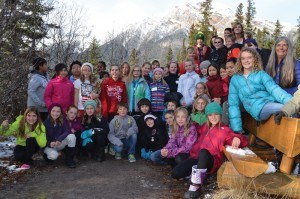
The room was loud.
For the most part kids only talk at full volume, so putting 46 of them together in a small hotel conference room and asking them to assemble into small groups becomes a thunderstorm of scraping chairs and high-pitched squealing.
But for Paulette Trottier and the other Jasper Elementary School teachers who brought the kids here, it’s worth it.
On Oct. 27, the teachers spent the day at Pyramid Lake Resort, teaching their charges how to become peer mediators.
They were using the Kids Helping Kids program, a curriculum developed over more than 20 years by Jasper Elementary staff.
The idea behind Kids Helping Kids is to train Grades 5 and 6 students to become conflict mediators, so they can help their younger peers sort out disputes without going to teachers or the principal.
They learn how to define and recognize conflict, the importance of confidentiality and are given the tools to help their peers work through conflicts in a fair way.
Kailee Chorneyko is a Grade 6 student teacher at Jasper Elementary, who herself went through the program when she was a youngster.
She said the program is important because it gives students skills they will potentially use for the rest of their lives.
“It’s not only teaching kids how to solve their problems, but it also [teaches] bullying prevention. They learn to look at themselves, and think, ‘OK, is what I’m doing hurting someone else?’ and that’s a big thing,” she said.
She recalls that the program gave her a new perspective on bullying, and made her want to change things.
“I remember thinking, ‘OK, stopping bullying is cool now.’ After taking this course I thought, I want to stop bullying, this is cool, rather than being shy about it.”
Trottier explained that each year students interested in joining the program write a letter explaining why they believe they would make good peer mediators. It’s an inclusive program, and she generally accepts anyone who puts in the effort.
“Sometimes some of these kids are the ones that need some of these skills—so we want to give everyone the opportunity who wants to take it,” she explained.
After they are trained, the students will each volunteer for one or two sessions a month. During lunch-hour they make themselves available to any of their peers “and when kids come in, they help them come up with their own solutions.”
Trottier said the great thing about Kids Helping Kids is that the skills the students learn not only help them resolve conflict with their peers, but they are life lessons that trickle down through their friends and families.
In the end, she said, they’re not just helping each other, but hopefully the entire community.
Trevor Nichols
[email protected]
